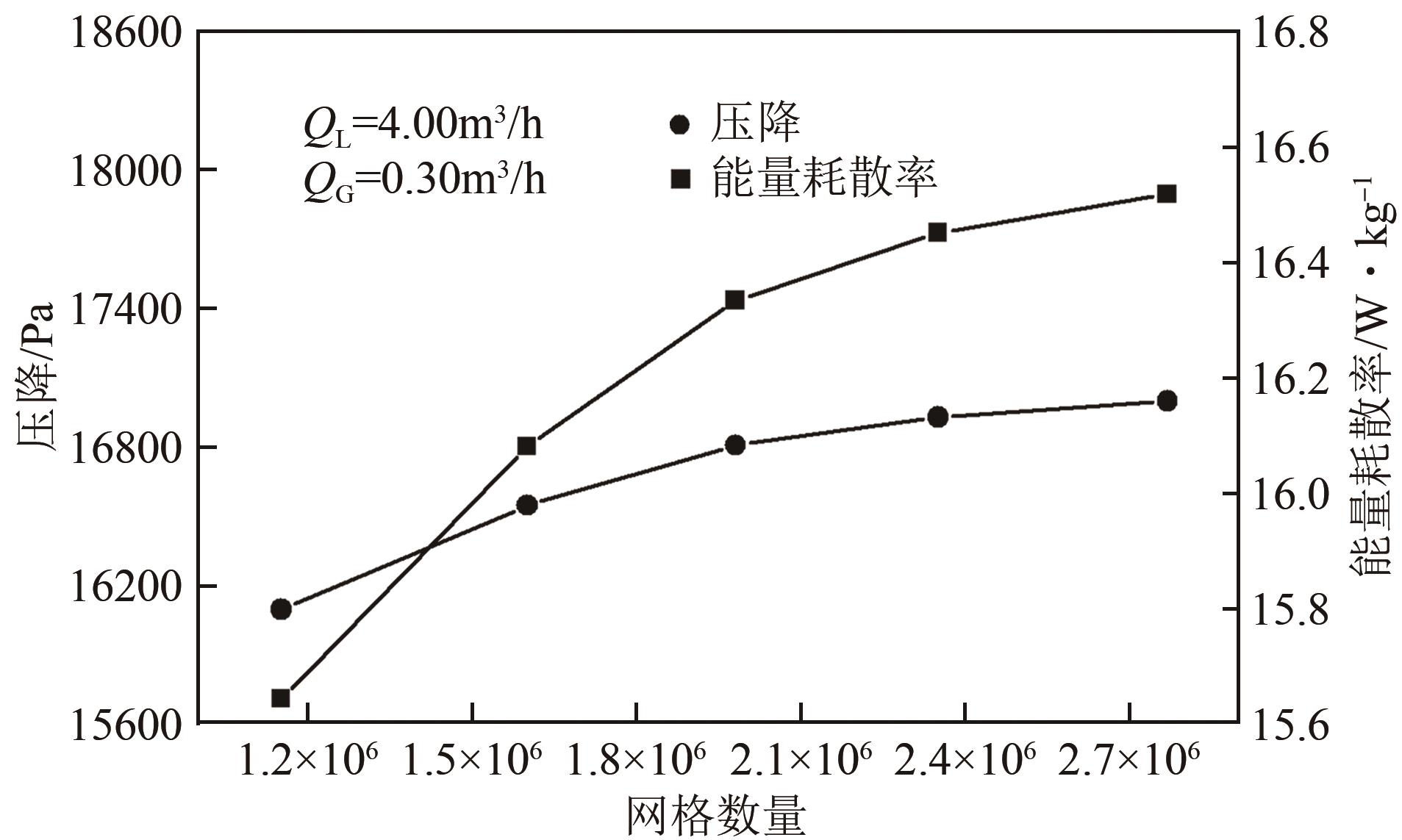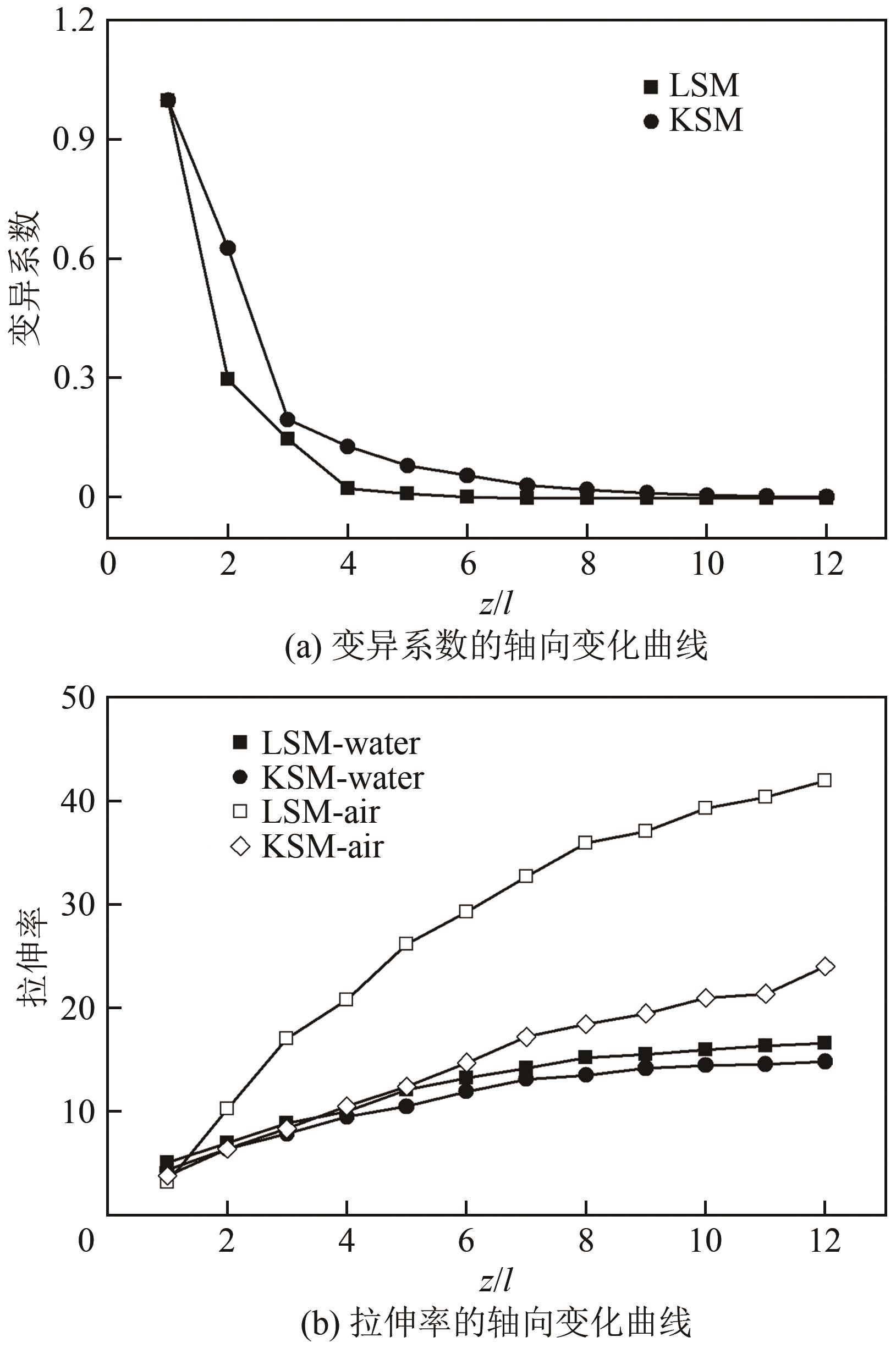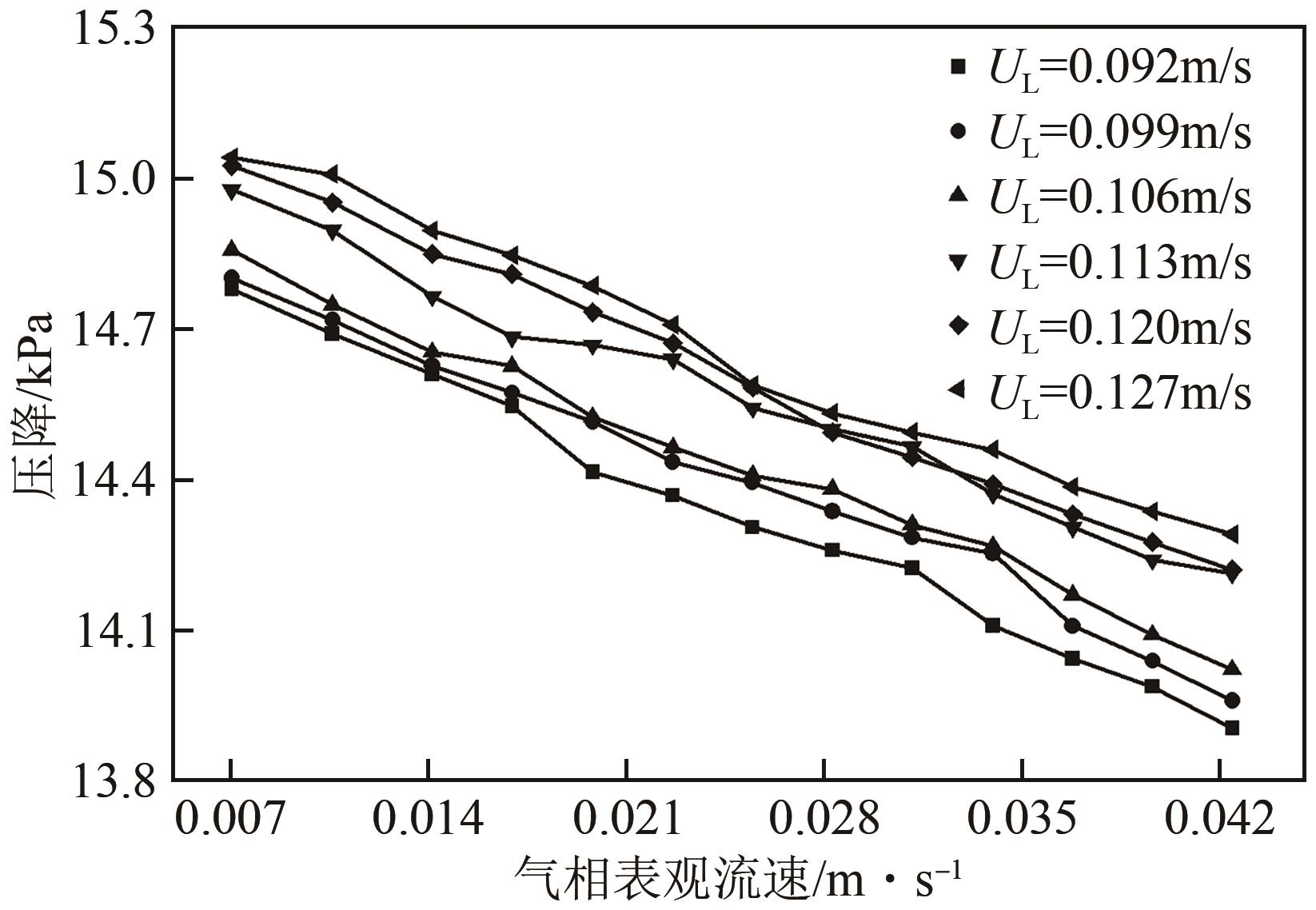Chemical Industry and Engineering Progress ›› 2023, Vol. 42 ›› Issue (12): 6180-6190.DOI: 10.16085/j.issn.1000-6613.2023-0183
• Chemical processes and equipment • Previous Articles
Enhancement of gas-liquid flow mixing and mass transfer in Lightnin static mixer
YU Yanfang1( ), LI Yu1, MENG Huibo2(
), LI Yu1, MENG Huibo2( ), LIU Huanchen1
), LIU Huanchen1
- 1.School of Mechanical and Power Engineering, Shenyang University of Chemical Technology, Shenyang 110142, Liaoning, China
2.College of New Energy, China University of Petroleum (East China), Qingdao 266580, Shandong, China
-
Received:2023-02-13Revised:2023-03-14Online:2024-01-08Published:2023-12-25 -
Contact:MENG Huibo
Lightnin静态混合器内气液两相混合与传质强化特性
- 1.沈阳化工大学机械与动力工程学院,辽宁 沈阳 110142
2.中国石油大学(华东)新能源学院,山东 青岛 266580
-
通讯作者:孟辉波 -
作者简介:禹言芳(1979—),女,博士,副教授,研究方向化工过程强化。E-mail: taroyy@163.com。 -
基金资助:辽宁特聘教授计划(辽教函〔2018〕35号);国家自然科学基金(21476142);青岛市自然科学基金(23-2-1-236-zyyd-jch);辽宁省教育厅重点项目(LJKZ0429);辽宁省自然科学基金(2022-MS-290);中国石油大学(华东)引进人才科研基金(R20220113)
CLC Number:
Cite this article
YU Yanfang, LI Yu, MENG Huibo, LIU Huanchen. Enhancement of gas-liquid flow mixing and mass transfer in Lightnin static mixer[J]. Chemical Industry and Engineering Progress, 2023, 42(12): 6180-6190.
禹言芳, 李毓, 孟辉波, 刘桓辰. Lightnin静态混合器内气液两相混合与传质强化特性[J]. 化工进展, 2023, 42(12): 6180-6190.
share this article
Add to citation manager EndNote|Ris|BibTeX
URL: https://hgjz.cip.com.cn/EN/10.16085/j.issn.1000-6613.2023-0183
| 模型 | 索特平均直径/mm | 相对偏差/% |
|---|---|---|
| Luo-Turbulent | 2.808 | 4.23 |
| Luo-Liao | 2.388 | 4.91 |
| Luo-Prince | 3.552 | 21.14 |
| Luo-Luo | 7.321 | 153.89 |
| Lehr-Turbulent | 1.492 | 48.97 |
| Lehr-Liao | 1.149 | 60.65 |
| Lehr-Prince | 2.132 | 27.05 |
| Lehr-Luo | 6.161 | 110.96 |
| 模型 | 索特平均直径/mm | 相对偏差/% |
|---|---|---|
| Luo-Turbulent | 2.808 | 4.23 |
| Luo-Liao | 2.388 | 4.91 |
| Luo-Prince | 3.552 | 21.14 |
| Luo-Luo | 7.321 | 153.89 |
| Lehr-Turbulent | 1.492 | 48.97 |
| Lehr-Liao | 1.149 | 60.65 |
| Lehr-Prince | 2.132 | 27.05 |
| Lehr-Luo | 6.161 | 110.96 |
| 1 | 初广文, 廖洪钢, 王丹, 等. 微纳介尺度气液反应过程强化[J]. 化工学报, 2021, 72(7): 3435-3444. |
| CHU Guangwen, LIAO Honggang, WANG Dan, et al. Gas-liquid reaction process intensification at micro-/nano-mesoscale[J]. CIESC Journal, 2021, 72(7): 3435-3444. | |
| 2 | 刘有智. 谈过程强化技术促进化学工业转型升级和可持续发展[J]. 化工进展, 2018, 37(4): 1203-1211. |
| LIU Youzhi. Discussion on process intensification technology to promote the transformation, upgrading and sustainable development of chemical industry[J]. Chemical Industry and Engineering Progress, 2018, 37(4): 1203-1211. | |
| 3 | CHABANON E, SHEIBAT-OTHMAN N, MDERE O, et al. Drop size distribution monitoring of oil-in-water emulsions in SMX+ static mixers: Effect of operating and geometrical conditions[J]. International Journal of Multiphase Flow, 2017, 92: 61-69. |
| 4 | THAKUR R K, VIAL C, NIGAM K D P, et al. Static mixers in the process industries — A review[J]. Chemical Engineering Research and Design, 2003, 81(7): 787-826. |
| 5 | GHANEM A, LEMENAND T, DELLA VALLE D, et al. Static mixers: Mechanisms, applications, and characterization methods—A review[J]. Chemical Engineering Research and Design, 2014, 92(2): 205-228. |
| 6 | HEYOUNI A, ROUSTAN M, DO-QUANG Z. Hydrodynamics and mass transfer in gas-liquid flow through static mixers[J]. Chemical Engineering Science, 2002, 57(16): 3325-3333. |
| 7 | AZIZI F, TAWEEL A M AL. Mass transfer in an energy-efficient high-intensity gas-liquid contactor[J]. Industrial & Engineering Chemistry Research, 2015, 54(46): 11635-11652. |
| 8 | ALTABASH G, AL-HINDI M, AZIZI F. Intensifying the absorption of CO2 in water using a static mixer. part I: Effect of measurement technique[J]. Industrial & Engineering Chemistry Research, 2020, 59(25): 11691-11704. |
| 9 | RABHA S, SCHUBERT M, GRUGEL F, et al. Visualization and quantitative analysis of dispersive mixing by a helical static mixer in upward co-current gas-liquid flow[J]. Chemical Engineering Journal, 2015, 262(15): 527-540. |
| 10 | MEINECKE M, KILZER A, WEIDNER E. Imaging method for mass transport measurements in a two-phase bubbly flow of supercritical CO2 and viscous liquids in a static mixer[J]. The Journal of Supercritical Fluids, 2020, 159(1): 104757. |
| 11 | SCALA M, GAMET L, L-M MALBEC, et al. Hydrodynamics of gas-liquid dispersion in transparent Sulzer static mixers SMXTM [J]. Chemical Engineering Science, 2020, 213(23): 115398. |
| 12 | MENG Huibo, HAO Yuning, YU Yanfang, et al. Experimental study of gas-liquid two-phase bubbly flow characteristics in a static mixer with three twisted leaves[J]. Korean Journal of Chemical Engineering, 2020, 37(11): 1859-1866. |
| 13 | XU Yanxia, WANG Lüliang, WANG Yongjie, et al. Gas-liquid flow pattern identification and bubble characteristics analysis in a static mixer based HiPOxTM reactor[J]. Chemical Engineering Science, 2023, 267(5): 118269. |
| 14 | ZIDOUNI F, KREPPER E, RZEHAK R, et al. Simulation of gas-liquid flow in a helical static mixer[J]. Chemical Engineering Science, 2015, 137(1): 476-486. |
| 15 | LUO He’an, SVENDSEN H F. Theoretical model for drop and bubble breakup in turbulent dispersions[J]. AIChE Journal, 1996, 42(5): 1225-1233. |
| 16 | HADDADI M M, HOSSEINI S H, RASHTCHIAN D, et al. CFD modeling of immiscible liquids turbulent dispersion in Kenics static mixers: Focusing on droplet behavior[J]. Chinese Journal of Chemical Engineering, 2020, 28(2): 348-361. |
| 17 | MENG Huibo, WANG Jianbao, YU Yanfang, et al. CFD-PBM numerical study on liquid-liquid dispersion in the Q-type static mixer[J]. Industrial & Engineering Chemistry Research, 2021, 60(49): 18121-18135. |
| 18 | LEHR F, MILLIES M, MEWES D. Bubble-size distributions and flow fields in bubble columns[J]. AIChE Journal, 2002, 48(11): 2426-2443. |
| 19 | WANG Tiefeng, WANG Jinfu, JIN Yong. A novel theoretical breakup kernel function for bubbles/droplets in a turbulent flow[J]. Chemical Engineering Science, 2003, 58(20): 4629-4637. |
| 20 | WU Yuxue, CHEN Hang, SONG Xingfu. Experimental and numerical study on the bubble dynamics and flow field of a swirl flow microbubble generator with baffle internals[J]. Chemical Engineering Science, 2022, 263(14): 118066. |
| 21 | HAN Luchang, LUO He’an, LIU Yuejin. A theoretical model for droplet breakup in turbulent dispersions[J]. Chemical Engineering Science, 2011, 66(4): 766-776. |
| 22 | HAN Luchang, GONG Shenggao, LI Yongqiang, et al. A novel theoretical model of breakage rate and daughter size distribution for droplet in turbulent flows[J]. Chemical Engineering Science, 2013, 102(11): 186-199. |
| 23 | HAN Luchang, GONG Shenggao, LI Yongqiang, et al. Influence of energy spectrum distribution on drop breakage in turbulent flows[J]. Chemical Engineering Science, 2014, 117(27): 55-70. |
| 24 | ZHANG Xibao, LUO Zhenghong. Effects of bubble coalescence and breakup models on the simulation of bubble columns[J]. Chemical Engineering Science, 2020, 226(23): 115850. |
| 25 | XING Chutian, WANG Tiefeng, GUO Kunyu, et al. A unified theoretical model for breakup of bubbles and droplets in turbulent flows[J]. AIChE Journal, 2015, 61(4): 1391-1403. |
| 26 | LIAO Yixiang, RZEHAK R, LUCAS D, et al. Baseline closure model for dispersed bubbly flow: Bubble coalescence and breakup[J]. Chemical Engineering Science, 2015, 122(27): 336-349. |
| 27 | HUANG Guangyuan, CAI Kangbei, CHEN Wuguang, et al. Numerical simulation of two-phase hydrodynamics and mass transfer inside a serpentine tubular gas-liquid reactor[J]. Chemical Engineering Science, 2021, 245(14): 116960. |
| 28 | GUO Xiaofeng, ZHOU Qiang, LI Jun, et al. Implementation of an improved bubble breakup model for TFM-PBM simulations of gas-liquid flows in bubble columns[J]. Chemical Engineering Science, 2016, 152(2): 255-266. |
| 29 | SHI Weibin, YANG Jie, LI Guang, et al. Modelling of breakage rate and bubble size distribution in bubble columns accounting for bubble shape variations[J]. Chemical Engineering Science, 2018, 187(21): 391-405. |
| 30 | TSOURIS C, TAVLARIDES L L. Breakage and coalescence models for drops in turbulent dispersions[J]. AIChE Journal, 1994, 40(3): 395-406. |
| 31 | AZIZI F, TAWEEL A M AL. Algorithm for the accurate numerical solution of PBE for drop breakup and coalescence under high shear rates[J]. Chemical Engineering Science, 2010, 65(23): 6112-6127. |
| 32 | AZIZI F, TAWEEL A M AL. Turbulently flowing liquid-liquid dispersions. Part I: Drop breakage and coalescence[J]. Chemical Engineering Journal, 2011, 166(2): 715-725. |
| 33 | LEBAZ N, AZIZI F, SHEIBAT-OTHMAN N. Modeling droplet breakage in continuous emulsification using static mixers in the framework of the entire spectrum of turbulent energy[J]. Industrial & Engineering Chemistry Research, 2022, 61(1): 541-553. |
| 34 | VALDÉS J P, KAHOUADJI L, MATAR O K. Current advances in liquid-liquid mixing in static mixers: A review[J]. Chemical Engineering Research and Design, 2022, 177: 694-731. |
| 35 | 禹言芳, 刘桓辰, 孟辉波, 等. Lightnin静态混合器内气泡分散流体动力学特性实验研究[J]. 化工学报, 2022, 73(8): 3565-3575. |
| YU Yanfang, LIU Huanchen, MENG Huibo, et al. Experimental investigation of turbulent dispersion and hydrodynamic behavior of bubble in Lightnin static mixer[J]. CIESC Journal, 2022, 73(8): 3565-3575. | |
| 36 | GUAN Xiaoping, YANG Ning. Bubble properties measurement in bubble columns: From homogeneous to heterogeneous regime[J]. Chemical Engineering Research and Design, 2017, 127: 103-112. |
| 37 | YU Yanfang, YANG Peng, MENG Huibo, et al. Bubble morphology analysis and pressure drop of gas-liquid two-phase flow inside a quarto static mixer[J]. Industrial & Engineering Chemistry Research, 2022, 61(50): 18574-18587. |
| 38 | TOMIYAMA A, KATAOKA I, ZUN I, et al. Drag coefficients of single bubbles under normal and micro gravity conditions[J]. JSME International Journal Series B: Fluids and Thermal Engineering, 1998, 41(2): 472-479. |
| 39 | MENG Huibo, HAN Mengqi, YU Yanfang, et al. Numerical evaluations on the characteristics of turbulent flow and heat transfer in the Lightnin static mixer[J]. International Journal of Heat and Mass Transfer, 2020, 156: 119788. |
| 40 | CHEN Siyuan, OUYANG Yi, VANDEWALLE L A, et al. CFD analysis on hydrodynamics and residence time distribution in a gas-liquid vortex unit[J]. Chemical Engineering Journal, 2022, 446: 136812. |
| 41 | MENTER F R. Two-equation eddy-viscosity turbulence models for engineering applications[J]. AIAA Journal, 1994, 32(8): 1598-1605. |
| 42 | PRINCE M J, BLANCH H W. Bubble coalescence and break-up in air-sparged bubble columns[J]. AIChE Journal, 1990, 36(10): 1485-1499. |
| 43 | LUO He’an. Breakup and liquid circulation in bubble column reactors[D]. Trondheim: Norwegian Institute of Technology, 1993. |
| 44 | SAFFMAN P G, TURNER J S. On the collision of drops in turbulent clouds[J]. Journal of Fluid Mechanics, 1956, 1(1): 16-30. |
| 45 | ABRAHAMSON J. Collision rates of small particles in a vigorously turbulent fluid[J]. Chemical Engineering Science, 1975, 30(11): 1371-1379. |
| 46 | LIAO Yixiang, LUCAS D. A literature review on mechanisms and models for the coalescence process of fluid particles[J]. Chemical Engineering Science, 2010, 65(10): 2851-2864. |
| 47 | ANSYS Fluent 16. 0 Theory Guide[EB/OL]. . |
| 48 | MENG Huibo, MENG Tong, YU Yanfang, et al. Experimental and numerical investigation of turbulent flow and heat transfer characteristics in the Komax static mixer[J]. International Journal of Heat and Mass Transfer, 2022, 194(15): 123006. |
| 49 | MENG Huibo, WANG Feng, YU Yanfang, et al. A numerical study of mixing performance of high-viscosity fluid in novel static mixers with multitwisted leaves[J]. Industrial & Engineering Chemistry Research, 2014, 53(10): 4084-4095. |
| 50 | GOLDSHMID J, SAMET M, WAGNER M. Turbulent mixing at high dilution ratio in a Sulzer-Koch static mixer[J]. Industrial & Engineering Chemistry Process Design and Development, 1986, 25(1): 108-116. |
| [1] | CHEN Kuangyin, LI Ruilan, TONG Yang, SHEN Jianhua. Structure design of gas diffusion layer in proton exchange membrane fuel cell [J]. Chemical Industry and Engineering Progress, 2023, 42(S1): 246-259. |
| [2] | YANG Hanyue, KONG Lingzhen, CHEN Jiaqing, SUN Huan, SONG Jiakai, WANG Sicheng, KONG Biao. Decarbonization performance of downflow tubular gas-liquid contactor of microbubble-type [J]. Chemical Industry and Engineering Progress, 2023, 42(S1): 197-204. |
| [3] | ZHAO Chen, MIAO Tianze, ZHANG Chaoyang, HONG Fangjun, WANG Dahai. Heat transfer characteristics of ethylene glycol aqueous solution in slit channel under negative pressure [J]. Chemical Industry and Engineering Progress, 2023, 42(S1): 148-157. |
| [4] | WANG Lele, YANG Wanrong, YAO Yan, LIU Tao, HE Chuan, LIU Xiao, SU Sheng, KONG Fanhai, ZHU Canghai, XIANG Jun. Influence of spent SCR catalyst blending on the characteristics and deNO x performance for new SCR catalyst [J]. Chemical Industry and Engineering Progress, 2023, 42(S1): 489-497. |
| [5] | LUO Cheng, FAN Xiaoyong, ZHU Yonghong, TIAN Feng, CUI Louwei, DU Chongpeng, WANG Feili, LI Dong, ZHENG Hua’an. CFD simulation of liquid distribution in different distributors in medium-low temperature coal tar hydrogenation reactor [J]. Chemical Industry and Engineering Progress, 2023, 42(9): 4538-4549. |
| [6] | ZHAO Xi, MA Haoran, LI Ping, HUANG Ailing. Simulation analysis and optimization design of mixing performance of staggered impact micromixer [J]. Chemical Industry and Engineering Progress, 2023, 42(9): 4559-4572. |
| [7] | BU Zhicheng, JIAO Bo, LIN Haihua, SUN Hongyuan. Review on computational fluid dynamics (CFD) simulation and advances in pulsating heat pipes [J]. Chemical Industry and Engineering Progress, 2023, 42(8): 4167-4181. |
| [8] | CHEN Weiyang, SONG Xin, YIN Yaran, ZHANG Xianming, ZHU Chunying, FU Taotao, MA Youguang. Effect of liquid viscosity on bubble interface in the rectangular microchannel [J]. Chemical Industry and Engineering Progress, 2023, 42(7): 3468-3477. |
| [9] | LIU Houli, GU Zhonghao, YANG Kang, ZHANG Li. Effect of groove width on pool boiling heat transfer characteristics in 3D printing groove structure [J]. Chemical Industry and Engineering Progress, 2023, 42(5): 2282-2288. |
| [10] | LU Xingfu, DAI Bo, YANG Shiliang. Super-quadric discrete element method investigation of mixing behaviors of cylindrical particles in a rotating drum [J]. Chemical Industry and Engineering Progress, 2023, 42(5): 2252-2261. |
| [11] | PANG Liping, YUAN Hu, QIU Wensheng, DUAN Liqiang, LI Wenxue. Hydrodynamic characteristics during peaking operation in utility boiler [J]. Chemical Industry and Engineering Progress, 2023, 42(4): 1708-1718. |
| [12] | TIAN Qikai, ZHENG Haiping, ZHANG Shaobin, ZHANG Jing, YU Ziyi. Advances in mixing enhanced microfluidic channels [J]. Chemical Industry and Engineering Progress, 2023, 42(4): 1677-1687. |
| [13] | YAN Xingqing, DAI Xingtao, YU Jianliang, LI Yue, HAN Bing, HU Jun. Research progress of high-pressure hydrogen leakage and jet flow [J]. Chemical Industry and Engineering Progress, 2023, 42(3): 1118-1128. |
| [14] | ZHANG Jianwei, XU Rui, ZHANG Zhongchuang, DONG Xin, FENG Ying. Mixing characteristics of concentration field in impingement flow reactor based on convolutional neural network [J]. Chemical Industry and Engineering Progress, 2023, 42(2): 658-668. |
| [15] | LIU Zhaoxuan, ZHANG Chengbin, HAN Qun, JIANG Haitao, LI Wenming. Numerical simulation of fluid flow and heat transfer characteristics in a saw-like microchannel [J]. Chemical Industry and Engineering Progress, 2023, 42(11): 5622-5636. |
| Viewed | ||||||
|
Full text |
|
|||||
|
Abstract |
|
|||||










